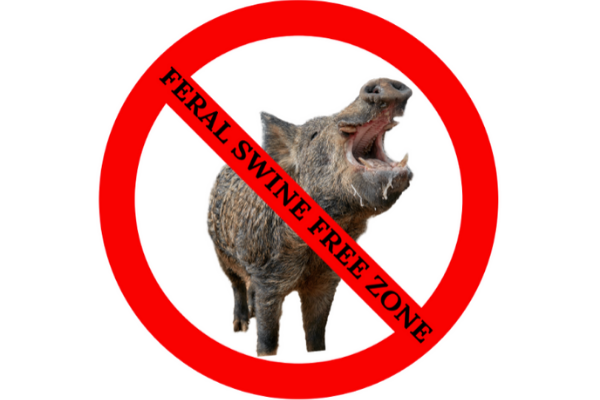OKLAHOMA CITY – Feral swine have become a concern across Oklahoma because of their increasing numbers and the damage they inflict. Wild hogs have been detected in at least 70 of the state's 77 counties, but they are most prevalent across the southern parts of Oklahoma, according to the Oklahoma Department of Wildlife Conservation. “It’s hard to pin down,” said Scott Alls, state director of Wildlife Services in the U.S. Department of Agriculture’s Animal and Plant Health Inspection Service (USDA- APHIS). “They don’t have a home range.” Oklahoma County has not been exempt from the wild pig invasion. “We’re eaten up with them,” Alls said. More than 100 feral hogs have been caught in eastern Oklahoma County in the vicinity of Choctaw, Luther and Harrah, he said.
WILD HOGS ARE DESTRUCTIVE
Feral swine congregate in groups called “sounders.” Each sounder can tear up several acres every night looking for food, which can include cropland, pastures, golf courses, residential lawns – even cemeteries, said Trey Lam, executive director of the Oklahoma Conservation Commission. A feral hog will eat about 4% of its body weight daily, according to the Oklahoma Department of Wildlife Conservation (ODWC).
BESIDES PROPERTY DESTRUCTION, OTHER CONCERNS ABOUT FERAL SWINE ARE:
Population growth. Feral swine have high reproductive potential; piglets become sexually mature at about six months of age and have their first litter at nine months, Alls said. Estimates place the feral swine population in Oklahoma from 600,000 to 1.5 million. Wild hogs have few natural predators. Disease transmission. Feral swine can be infected with brucellosis and leptospirosis, which can be passed to people. Pseudorabies is found in about one-third of the feral swine population. This disease can spread to dogs, cattle, goats and sheep. Feral hogs also can carry and transmit many other diseases. Threat to wildlife. Besides the diseases they transmit, feral swine put stress on native species. The hogs consume food resources that also support deer, raccoons, black bears and opossums. The hogs not only destroy habitat, they also prey on the eggs and young of native ground-nesting birds and reptiles, including threatened or endangered species, the USDA reports. Game birds such as wild turkeys, grouse and quail are adversely affected.
FERAL HOGS KILL MAMMALS, REPTILES
Feral hogs actively hunt small mammals, frogs, lizards and snakes, according to the USDA, and have even been documented killing and eating deer fawns, Lam said. “These animals are perceived to be herbivores but actually they’re omnivores,” Alls said. In a rare incident, a woman who was found dead Nov. 24 outside a home in rural south Texas was killed by wild hogs, authorities reported. The body of the 59-year-old woman was discovered in the front yard of a residence in Anahuac, east of Houston, sheriff’s investigators said. An autopsy determined the victim died of blood loss resulting from a feral hog attack. No wild hog attacks on humans have been reported in Oklahoma, but a cow and her newly born calf were fatally attacked by a sounder of feral pigs last year on a farm near Ada, Alls said. “We killed 57 feral hogs in that area” shortly afterward, he said.
WILD HOGS CAN BE KILLED YEAR-ROUND ON PRIVATE LAND
It’s “open season” on wild pigs found on private property. Feral hogs may be taken year-round on private property during daylight hours or at night with permission from the landowner, lessee or occupant of the land. There is no restriction on the method of take of wild hogs on private property. In response to an executive order then-Gov. Mary Fallin issued in 2016, the ODWC instituted a procedure that allows hunters an exemption from existing hunting regulations that prohibit shooting at night. The goal of the new procedure is to provide landowners relief from feral swine while also protecting wildlife. Exemptions are issued for land areas, and only a deed- holding landowner (or a designee with written landowner permission) can register a property for a night-shooting exemption – when feral hogs are most active. The exemption procedure provides immediate approval for permission to shoot feral swine on the registered property at night. ODWC rules governing feral hog hunting can be found on page 35 of the state hunting regulations at http://www.eregulations. com/wp-content/ uploads/2019/07/19OKAB_ Hunting-LR3.pdf


